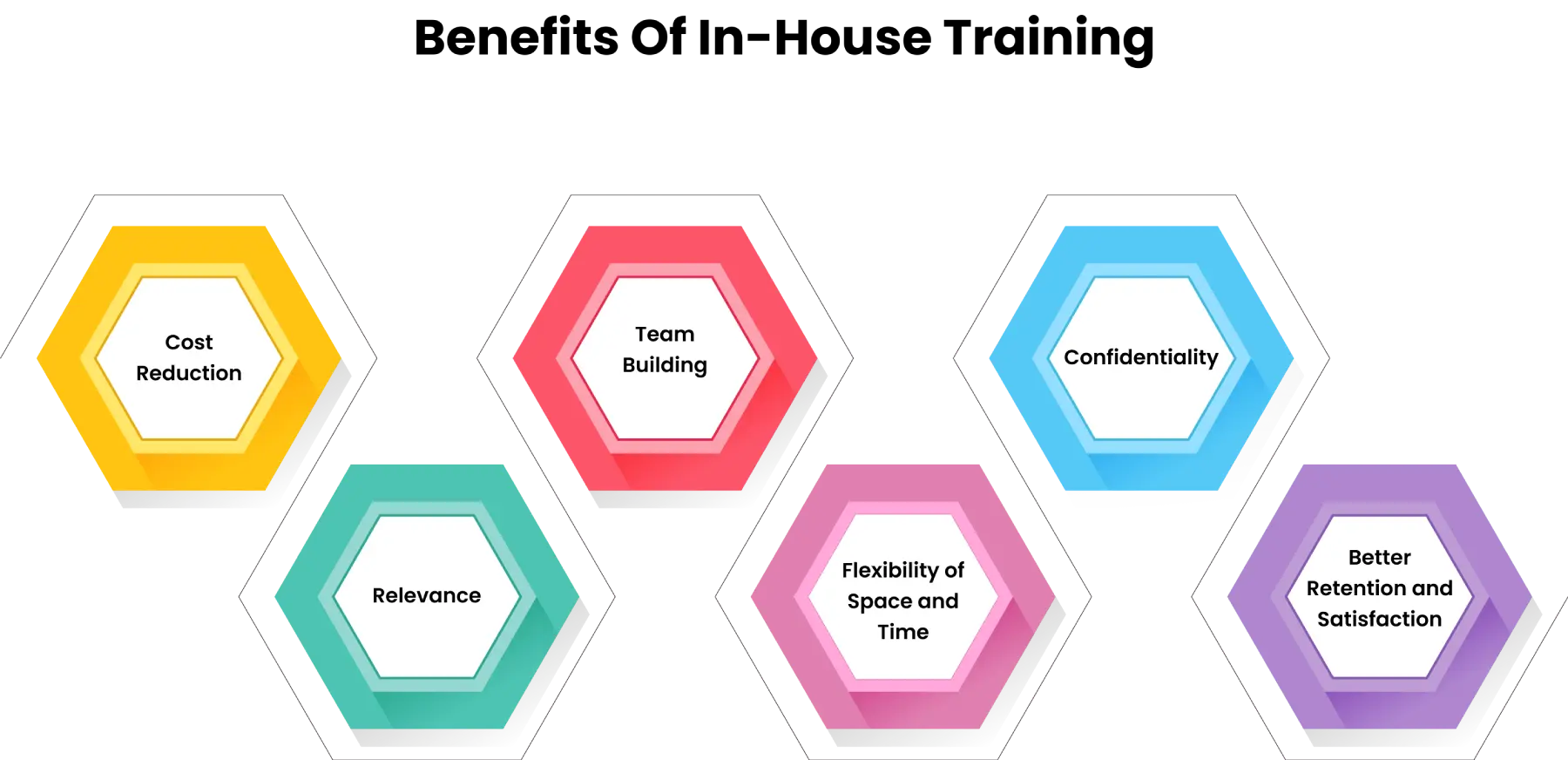In-House Training: Definition, Types, Benefits & Challenges
In-house training is an answer to the issues organizations face within a fast-paced competitive business landscape. Considerations for in-house training include; the time and money for employees to go outside of their organization for training, as they are trained in-house with all their internal resources available and at their convenience with a tailored training session to meet the organizational operational needs and culture.
What organizations find with in-house training are improved individual performance, organizational team collaboration, increased employee engagement, and loyalty to the company.
In-house training appears to be booming and at a time when a number of companies are looking to save money and build specific company skills; organizations are increasing budgets for in-house training. Moreover, studies suggest organizations that focus on employee learning and invest in internal training programs can experience up to 24% greater profit margins than companies that don’t focus on employee learning and invest in training programs. In-house training allows the organization to provide essential learning experiences for employees without having to worry about cost and delivery of programs/products.
Let’s take a closer look at what in-house training is, types of in-house training, and how you can effectively build a program for your organization.
What is In-house Training?
In-house training, sometimes referred to as internal training, is when organizations develop internal training using their own people, their own place of business and their own expertise, to provide their own training to employees. Mainly to develop or enhance work-related knowledge and skills, to ensure staff are able to meet current and future job requirements in the most efficient way, which could be areas that can include; technical skills, compliance training or training in employability and soft skills, to even training in management and leadership development, all conducted by the organization with own resources, trainers and digital platforms.
The primary goal of in-house training is to offer pertinent, responsive education that aligns with both the company’s objectives and budget, promotes cohesion among a team, and speeds up professional development. In-house training offers businesses more control than third-party or outsourced methods because in-house training can be more relevant to a company's needs, build cohesiveness among teams, and it is easier to measure in-house training results and impacts. Doing in-house training fosters a culture of sharing knowledge and learnings, promotes using the learnings in everyday work life and enhances the philosophy of continuous improvement.
It is important for organizations to adopt in-house training as it reduces costs by removing vendor fees, travel, and other external expenses, saving up to 40% . Tailored to team needs and real workplace situations, it keeps learning relevant, engaging, and directly applicable.
It also delivers quick results by enabling immediate skill application, improving performance without delays. Along with boosting productivity, it supports career growth and helps lower staff turnover, as employees who feel valued are more likely to stay.
What are the Different Types of In-house Training?
There are many forms of in-house training, here are some include:
On-Boarding & Orientation Training: Typically, onboarding and orientation training introduce new employees to the organization’s policies, culture, and expectations from both the employee and employer. It may include meeting team members, review roles and responsibilities, or addressing workplace processes. A carefully structured onboarding and orientation process may shape the new employee’s confidence, engagement, and productivity, laying the foundation for success in the new role.
Skills-based / Technical Training: This training overcomes or improves the knowledge, skills, and/or abilities an employee needs to effectively perform job requirements. This could include software applications, specialized machinery, and technical or job-specific procedures. This training allows employees to perform their work with proficiency, skill, efficiency, and safety, with reduced errors and improved overall performance.
Compliance Training: These programs aim to ensure employees know and comply with their legal, regulatory, and organizational obligations (e.g., workplace health and safety instructions, data protection laws , and ethical codes). Compliance training is essential to mitigate risks associated with operating in a legal and ethical manner and is often the minimum level of knowledge imparted, regardless of employees' knowledge.
Leadership & Management Training: Leadership and management training is usually designed for employees who are moving into leadership or supervisory roles. It shapes skills such as decision making, conflict management, team motivation, strategic thinking, and more. Leadership and management training prepares employees to lead a team to an organizational goal, manage resources, and develop a positive work environment .
Soft Skills Training: These training types relate to interpersonal behaviours and non-technical skills necessary for effective workplace communication and engagement, communication skills, team-based cooperation skills, adaptability, problem-solving, and creativity. Strong interpersonal behaviours and non-technical skills supplement technical skills, enabling employees to work together, overcome difficulties, and enhance an organization's overall culture.
Training can be delivered as workshops, seminars, e-learning, mentoring or even job shadowing - all with internal trainers or subject matter experts or a combination of both.
How to Create an Effective In-house Training Program?

Building a strong in-house training program requires an amount of planning time and aligning to business goals. Here is a blueprint.
Identify Training Needs: It's important to undertake an assessment of the current business to be able to complete a full training gap analysis to see what gaps exist, what performance issues exist, and what new competencies are required for your business to grow.
Set Learning Outcomes: Clearly defined and measurable learning area goals. Achieve & maintain a compliance rate of at least 90% on mandatory workplace policies after training completion . This provides a clear target & a way to measure the training's effectiveness.
Content & Materials: Create your training content that improves internal talent, uses industry standards & specifications, and is based on real company scenarios. This ensures the training is relevant, practical, and grounded in the company's specific context..
Method of Learning: Choose the appropriate mix of methodologies for training delivery based on the topic & the audience. This tailors the training approach to the learners' needs & the subject matter, maximizing comprehension & retention.
Train The Faculty: Train up the internal faculty to facilitate the learning with a focus on "teaching" the content, sufficient content knowledge, & techniques to facilitate engagement. This prepares instructors to be “effective educators”, not just subject matter experts.
Implementation of Program: Schedule dates for the sessions, define the learning goals, & emphasize attendance. This establishes a clear plan for rolling out the training & communicates its importance to participants.
Measuring Success: Consider designing assessments, surveys for feedback, and performance metrics tracking to measure the impacts of the tutoring and inform facilitators/managers to develop improvement actions for upcoming sessions.
What are the Benefits of in-house training?

Cost Reduction: Save on trainer fees, travel, and time away from work. Studies suggest that in-house training costs are 40% less than outsourced training. This lets businesses put the money they save back into other projects that will help them grow or train their employees.
Relevance: The training is regionally focused on processes and goals to apply as soon as the learning experience is completed, resulting in higher engagement. This direct application makes sure that workers can use what they learn right away, which increases productivity .
Team Building: Cross-departmental collaboration leads to naturally forming relationships that equate to knowledge sharing, empathy, and teamwork. These kinds of ties make the culture of the business stronger and help people work together on future projects.
Flexibility of Space and Time: Schedule learning or in-house training sessions to accommodate organizational constraints so that the business can continue untarnished. Customize the design to fit the needs of the organization. Make the design match the needs of the business while keeping routine activities running as smoothly as possible.
Confidentiality: Provides assurance to contractors that sensitive company information won't leave the premises. This keeps the firm ahead of the competition and lowers the danger of data breaches .
Better Retention and Satisfaction: Employees feel their training is better, they have job satisfaction and would be 33% less likely to leave their present employer. Better training leads to more engagement, which in turn leads to longer-term loyalty and lower turnover costs.
What are the Challenges of in-house training?
Equipment Heavy: Development, teaching, and maintenance of in-house content takes time and effort from your organization, so be prepared to invest. This could also mean that internal workers have to do more work, which could affect their regular duties.
Content Staleness: If training isn't revised frequently, you run the risk of outdated material that lacks relevance and can be ineffective at best. Employees may also lose interest or not use what they learned correctly if the information is out of date.
Credibility of Knowledge: Your in-house trainer may not have the credibility or expertise of a "trainer". This could make participants less confident in the instruction, which could have an effect on how much they learn overall.
Lack of Engagement: Using generic or one-off formats ignores the preferences of different styles of learners. This can lead to reduced retention rates and fewer chances to use skills on the job.
Limited Exposure and Innovation: Relying only on what exists internally may reduce any exposure you receive from using an external agency or their innovative perspectives on work. It may also limit the organization’s capacity to adapt to new patterns and best practices in the sector.
What Are Examples of In-house Training Programs that Worked?
Amazon Training Academy: Leverages a blend of onsite and online training to develop the capabilities of its frontline and technical employees. In addition, Amazon is playing its role in upskilling the workforce. At the same time, Amazon has developed its Associate2Tech program that helps warehouse employees transition into their IT roles to minimize people leaving.
AlphaSights Learning and Development: Leverages the subject matter experts in their company to become course developers, where AlphaSights has a 95% course completion rate among employees and received feedback that indicated high engagement from their employees, which has contributed to an ongoing upskilling of their workforce.
Mitsubishi Electric: Using a blended approach to train thousands of engineers, they managed to reduce their training costs by about 65% and resulting in 99% customer satisfaction .

